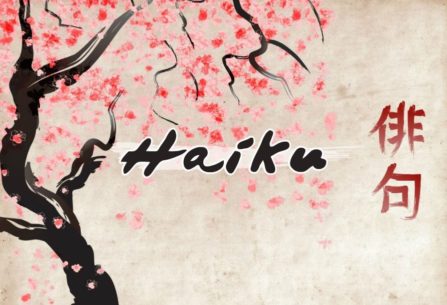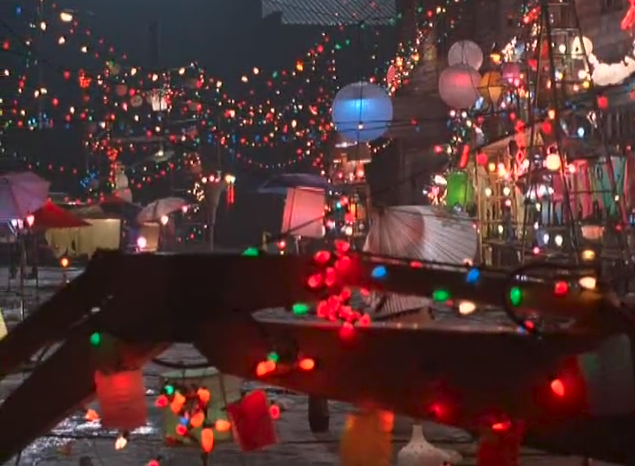at Three Deer Junction:
Mama sniffs, perks ears, a step –
We stand still, eyes locked.
Dunkirk NY – And so begins National Haiku Writing Month. Along with the above haiku, I am going to be so bold as to expand my thoughts a little more on why we should not fear, but rather embrace, 5-7-5 haiku. You can see my original post here on Medium.
As a preamble, let me state that I am not writing against anything, nor am I writing to express the superiority of one form over another. Free form haiku, with its emphasis on minimal syllables, is a fine form of haiku writing, and without doubt many beautiful haiku result from its use. I merely wish to argue for a better view and acceptance of the 5-7-5 form, and to put a fresh slant on such haiku by claiming the form as a specifically English language form of haiku, without reference to its Japanese origins. I certainly wouldn’t stop anyone from writing free form haiku, and my hope is that haiku writers will perhaps embrace the challenges that 5-7-5 presents and raise it to another level.
The crux of my argument lies primarily in moving away from comparing the two languages – English and Japanese – and focusing on English itself as a language rich in poetic potential for haiku or any other form of poetry. It is unfortunate in some ways that the discussion has centered on comparing on to syllables. This has been a huge distraction, and I think takes away from really seeing English for the language it is. Secondarily, I think the 5-7-5 form provides just that – a form – and I believe that adding the element of form and technique offers an additional challenge to the writing of haiku.
I’ve spent my adult life working with the works of William Shakespeare. He is recognized as one of the world’s great poets and playwrights, and the consensus is that he’s the greatest poet/playwright of the English language. He contributed enormously to the language itself, giving it many new words and phrases, and in his time revolutionized the art of playwriting, raising it to a level not seen before or since. I use his sense of style and language as a jumping-off point for how I look at 5-7-5 haiku. His most important contribution to the world of playwriting and poetry was his extensive use of blank verse, otherwise know as iambic pentameter. His lines of verse in his plays and poems, for the most part, consisted of 10 syllables in the form of unstress/STRESS (an iamb). Five feet – or instances – of iambs equaled one line of poetry; hence iambic pentameter. Shakespeare also was not concerned about rhymes, and so unrhymed iambic pentameter became known as “blank verse.”
What’s important to understand about blank verse is that it is the form of poetic construction that most mimics the natural rhythms of conversational speech in English. Quite often, when people have normal conversations, a good percentage of their conversation comes out in iambic form. “I need to get a dozen eggs and milk” is a line of iambic pentameter. As a language, English seems to flow best in this form. Every language has such a natural flow or rhythm to it, and one only has to listen to the spoken language long enough to get that flow, even if they cannot understand the actual words. From Japanese to Latin, the rhythmic flow of the language is usually what best constitutes its sense of poetry. For English, the iamb, with its unstress/STRESS format, seems to work most naturally. Am I arguing that haiku should be written in iambic pentameter? Of course not. But what I am arguing is that, by understanding the flow of iambic rhythms, you can write 5-7-5 haiku with some attention to this flow. You don’t have to have an exact pattern of constant iambs, but paying attention to the rhythm and flow of how the iambs within the haiku are working can give it a more poetic feel. It may be a reason why you might pick one word over another, and that is another gift of the English language to haiku – its expansive and magnificent vocabulary.
But why stick to the 17 syllables split as 5-7-5? Primarily because that amount of syllables, combined with a visual form on the page, offers an ideal opportunity to feel that rhythm and flow. Free form haiku is generally, in my experience, a little too short to feel that sense of linguistic musicality that 17 syllables can offer. It certainly has the ability to encapsulate a moment, but perhaps not a sense of linguistic joy. I find that, when reading or experiencing poetry, having the opportunity to see how the poet has used rhythms within the poem is part of the overall experience. Free form haiku tends, on the whole, to be more concerned with capturing the “haiku moment” and less with expressing that moment in a linguistic, rhythmic style. This is all well and good, to be sure, but I think there is something more to be gained by encapsulating these moments in a form. Even a river running free is contained in the form that its banks create, and its music is shaped by the stones and dirt its bed contains.
What is even more interesting is that the 5-7-5 format is all odd numbered. Iambs really ask for even numbers of syllables, and even in Shakespeare, lines that have 9 or 11 or even 5 syllables ask for an explanation (there are explanations, but no need to go into them here). So a writer of haiku in English using the 5-7-5 format is really faced with a double challenge: paying attention to the flow of the iambs, while at the same time using odd lines to create the form. While this does not rise to the level of paradox, it does offer a paradoxical challenge, and it is one that can add a sense of mystery and suspense to the haiku. Following the flow and then having it cut off can be compared to the kiregi in Japanese haiku, where a sense of cutting off the stream of thought can come into play and lend emotional flavor to the haiku.
5-7-5 haiku writing also offers us the sense of form, and form usually offers with it a sense of discipline. Most art forms have their specific techniques which must be mastered in order to produce the artwork. In Japanese, one speaks of kata, which is the form a particular practice takes. In martial arts, practitioners always have one or perhaps several forms that they practice and repeat so as to master their craft and discipline their bodies. In my own craft of acting, one follows certain techniques and forms that can aid in creating believable characters on stage. Fine artists develop techniques with brush strokes or potter’s wheels to achieve their artistic visions. The 5-7-5 format offers a form within which one can master a sense of style, rhythm and meaning, and perhaps even find their own personality within the form.
I have to emphasize that the point of studying and mastering form is ultimately to have “no form.” Many people believe that, by discarding and not worrying about form, they are free from restrictions and so can be more free to write better verse. I would argue the opposite; that mastering form is really the ultimate key to artistic freedom. The technique of any form of art should be so thoroughly mastered that someone experiencing the artistic product has no sense of the form at all – they only experience the artistic result. A person reading or hearing a 5-7-5 haiku should not sense the 5-7-5 format, but rather the rhythm, flow, narrative, and experience of the moment the haiku attempts to capture. The phrase “don’t let them see you sweat” makes the point well. One has to go beyond the mechanical employment of the form to write a good 5-7-5 haiku.
Lastly, I enjoy haiku because the 17 syllables offer the opportunity for more expansive narrative. Free form shorter haiku are quite capable of capturing a moment, but less capable of capturing a story (although I admit the very best ones really shine at capturing story and moment as a single experience). Human beings are by nature storytellers, and they are intrinsic to our sense of what life is about. We are constantly shaping our lives into story form, whether individually or as a community. In my experience, 17 syllables strikes that balance between capturing a moment and capturing a story about that moment quite well. I’ve compared this to drinking tea. A thimble of tea is too small for any real enjoyment; a shot glass of tea offers more flavor but can leave the body unsatisfied; a cup of tea offers the opportunity to savor the tea with more than one sip (perhaps two or three), and a mug of tea might be too much, as one might tire of the taste. A 17-syllable 5-7-5 haiku, well-written, can be a very rewarding cup of poetic tea, in that it can offer poetic rhythm, flow, an experienced moment, and a short narrative on that moment.
I enjoy writing both kinds of haiku. Sometimes a moment requires a free form haiku for me. Other times the 5-7-5 format works well. Bad haiku can be written in both forms, and one is not superior to another. I don’t think people should be discouraged from writing 5-7-5 haiku, and it is a shame that the NaHaiWriMo website appears to do so. Rather, we should be engaged in trying to help people write better 5-7-5 haiku, with more of an awareness of its possibilities. It is, in my opinion, an opportunity to create English language haiku that can stand on its own without being compared to Japanese language haiku. I am going to try to write as many 5-7-5 haiku as I can during February. Hopefully a few of the will turn out to be good examples of what I am talking about. -twl
Edit 2/5/20 – I’ve designed a new graphic to use with my 5-7-5 haiku, which appears at the top of the post. Please feel free to copy and use for yourself.









 I could go on, but I think I’ll stop there. It’s really not my purpose to
I could go on, but I think I’ll stop there. It’s really not my purpose to